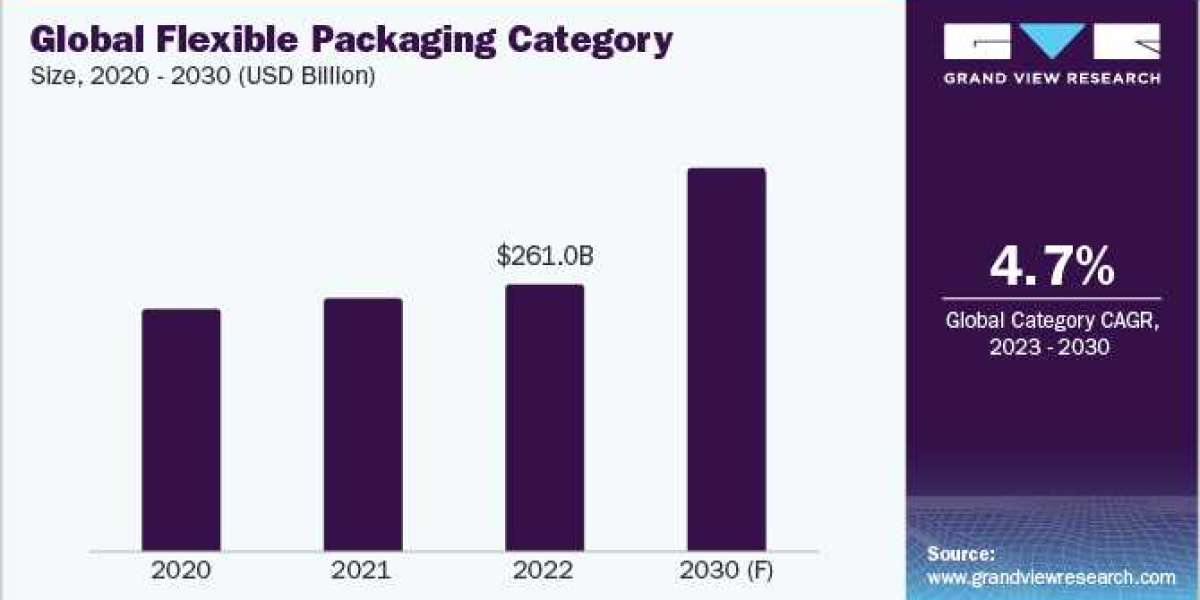Flexible Packaging Category - Procurement Intelligence
The flexible packaging category is expected to grow at a CAGR of 4.7% from 2023 to 2030. The growing use of these products in the pharmaceutical and food and beverage industries is anticipated to drive the demand. In 2022, Asia Pacific accounted for the highest proportion of the category share, with more than 38%. Flexible packaging has the primary advantage of reducing the amount of packaging materials used. They boast a low packaging ratio (up to five times less than alternatives), are highly customizable, lightweight, use less energy and water during production, occupy less space in landfills, and are highly customizable. More food businesses are exploring flexible packaging for their products. Producers, consumers, and retailers all benefit from flexible packaging in terms of sustainability.
One of the major trends in this category is the increasing use of sustainable plant-based packaging solutions. According to studies, polyethylene resin and/or paper derived from plants can currently be used to create flexible packaging. TricorBraun Flex's introduction of a completely biodegradable, plant-based flexible packaging material, named Biotre 3.0, in 2021 is an example of the same. A survey conducted by the Paper and Packaging Board in 2022 found that 72% of respondents reported dissatisfaction with the packaging solution and design of the product, which influenced their purchase decisions. E-commerce stores have begun to pay attention to flexible packaging because of this.
Order your copy of the Flexible Packaging category procurement intelligence report 2023-2030, published by Grand View Research, to get more details regarding day one, quick wins, portfolio analysis, key negotiation strategies of key suppliers, and low-cost/best-cost sourcing analysis
The overall packaging sector experienced a slowdown in MA activity in Q2 2023, as both transaction volume and valuations declined modestly. In the coming years, the ongoing global plastics treaty negotiations (which started in March 2022) will likely have a significant impact on flexible packaging. A few examples are:
- In August 2023, Amcor plc announced the launch of its high-barrier packaging made of paper in the North American region. As part of its “Amfiber” portfolio, the new recyclable product is known as AmFiber Performance Paper. The product adheres to the Repulpability Standards–curbside recycling−thereby enabling firms to offer consumers more environmentally friendly packaging. The product was already launched in Europe in June 2023 to include heat seal sachets for dry applications in beverages such as drinks powder, instant coffee, seasonings, and spices.
- In June 2023, Huhtamaki announced its decision to consolidate the production footprint of its Flexible Packaging business segment in Europe. It would close its manufacturing plant in Prague, Czech Republic, as part of this consolidation process. By March 31, 2024, all operations will be closed at the facility, including all production and support activities.
- In February 2023, Sealed Air Corporation (SEE) announced the acquisition of Liquibox for USD 1.15 billion in cash. The acquisition is expected to enhance the former’s fluids and liquids business segment, under its brand, CRYOVAC, which is Sealed Air’s fastest-growing segment.
- In February 2022, Sealed Air Corporation (SEE) acquired Ireland-based Foxpak Flexibles Limited. Foxpak would expand on SEE's digital/smart packaging solutions, where graphic design and digital printing are major value-creating areas.
Flexible Packaging Sourcing Intelligence Highlights
- The global flexible packaging category features a fragmented landscape with the presence of several international and regional players. By providing a variety of unique shapes and general conveniences that are appropriate for a variety of purposes, pouch manufacturers are literally and figuratively going the extra mile to meet the needs of consumers.
- The major cost components associated with the production of flexible packaging are raw materials, energy, printing-converting-packaging processes, equipment, types of products chosen for production, and labor.
- More than 60% - 65% of pharmaceutical companies fully outsource their packaging requirements due to its complexity to a third-party contractor. Outsourcing enables a company to obtain a partner who can take care of a variety of regulatory and quick launch requirements, including international regulatory requirements for multi-market launches.
- The most preferred countries for sourcing this category’s materials and films are India, China, Vietnam, Turkey, and Germany. As of May 2023, India is the world's leading exporter of flexible packaging material, shipping the majority of its products to the UK, the U.S., and South Africa.
List of Key Suppliers
- Bemis Company, Inc.
- Amcor plc
- Mondi plc
- Huhtamaki Oyj
- SEE (Sealed Air Corporation)
- Constantia Flexibles International GmbH
- Sonoco Products Company
- Ukrplastic Corporation
- Ampac Holdings LLC
- Wipak Walothen Gmbh (Wipak Group)
- SIG Group
- Aluflexpack AG
Browse through Grand View Research’s collection of procurement intelligence studies:
- Corn Procurement Intelligence Report, 2023 - 2030 (Revenue Forecast, Supplier Ranking Matrix, Emerging Technologies, Pricing Models, Cost Structure, Engagement Operating Model, Competitive Landscape)
- Commercial Real Estate Services Procurement Intelligence Report, 2023 - 2030 (Revenue Forecast, Supplier Ranking Matrix, Emerging Technologies, Pricing Models, Cost Structure, Engagement Operating Model, Competitive Landscape)
Flexible Packaging Procurement Intelligence Report Scope
- Flexible Packaging Category Growth Rate : CAGR of 4.7% from 2023 to 2030
- Pricing Growth Outlook : 15% - 25% increase (Annually)
- Pricing Models : Single, bundled, volume-based pricing model
- Supplier Selection Scope : Cost and pricing, past engagements, productivity, geographical presence
- Supplier Selection Criteria : By types of roll stock (barrier films, cold seal, resealable), pouch type (retort and hot fill pouch, stand up, closure option pouch), lidding types (retail package lid film, peel and reseal, non-food package lid films, food service lidding), operational capabilities, quality measures, technology, certifications, data privacy regulations, and others
- Report Coverage : Revenue forecast, supplier ranking, supplier positioning matrix, emerging technology, pricing models, cost structure, competitive landscape, growth factors, trends, engagement, and operating model
Brief about Pipeline by Grand View Research:
A smart and effective supply chain is essential for growth in any organization. Pipeline division at Grand View Research provides detailed insights on every aspect of supply chain, which helps in efficient procurement decisions.
Our services include (not limited to):
- Market Intelligence involving – market size and forecast, growth factors, and driving trends
- Price and Cost Intelligence – pricing models adopted for the category, total cost of ownerships
- Supplier Intelligence – rich insight on supplier landscape, and identifies suppliers who are dominating, emerging, lounging, and specializing
- Sourcing / Procurement Intelligence – best practices followed in the industry, identifying standard KPIs and SLAs, peer analysis, negotiation strategies to be utilized with the suppliers, and best suited countries for sourcing to minimize supply chain disruptions








